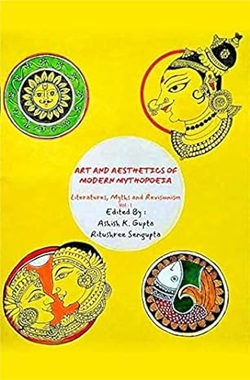Jan 05, 2026
Jan 05, 2026
Ashish Kumar Gupta and Ritushree Sengupta, editors. Art and Aesthetics of Modern Mythopoeia: Literatures, Myths and Revisionism, Vol. 1. New Delhi: Vishvanatha Kaviraja Institute, 2020, pp. xvi + 268, HB, Price 795, ISBN: 978-81-945995-1-7
 Art and Aesthetics of Modern Mythopoeia: Literatures, Myths and Revisionism is a collection of twenty two essays edited by Dr. Ashish Kumar Gupta and Dr. Ritushree Sengupta. Foreword written by Dr. Gautam Sengupta forms an important part of the book as it helps the reader understand the origin, presence, and influence of myths that make, in the words of Sengupta, “a bridge between ancient and modern worlds.” (vii) This book is a significant addition to cultural studies as it covers a vast range of writings and opens a door for further research in the emerging areas.
Art and Aesthetics of Modern Mythopoeia: Literatures, Myths and Revisionism is a collection of twenty two essays edited by Dr. Ashish Kumar Gupta and Dr. Ritushree Sengupta. Foreword written by Dr. Gautam Sengupta forms an important part of the book as it helps the reader understand the origin, presence, and influence of myths that make, in the words of Sengupta, “a bridge between ancient and modern worlds.” (vii) This book is a significant addition to cultural studies as it covers a vast range of writings and opens a door for further research in the emerging areas.
The very first chapter by Abhay Kumar Roy is remarkable. It is a study of the contemporary retellings of the Mahabharata in context of the burning of the Khandava forest that took lives of many creatures and many of them were compelled to run in all directions to save their lives. Probing ‘mindless massacre’ of Janmejay’s Snake Sacrifice as presented in Devdutt Patnaik’s Jaya complements the author’s contention. This chapter becomes more important in the context of trauma studies encompassing ‘terrorist attacks’, ‘genocide’, mass migration, environmental degradation, and climate change. The author has unlocked a new landscape of understanding and interpreting the holocausts that remained neglected due to religious shade.
There are six more chapters on retellings of the Indian epics – the Mahabharata and the Ramayana in which two are based on Kavita Kane’s Karna’s Wife: The Outcaste’s Queen (2013). Debalina Sengupta and Joydeep Banerjee, in their joint chapter, have foregrounded ‘pain’, ‘humiliation’ and ‘torment’ of the female ‘muted sufferers’ of this novel unlike valorization of ‘patriarchal narrative’ by Vyasa in the
Mahabharata. In another chapter, Sebonti Roy Chowdhury has vindicated ‘double marginalization’ in this novel. An important character of the Mahabharata, Shikhandi, has been studied by Medha Bhadra Chowdhury from ‘a queer perspective’ unlike the ‘political’ perspective of the epic. In the retelling of the Ramayana, Volga’s The Liberation of Sita (2016) has been taken by Malavika Ajikumar in which the author analyses deconstruction of the patriarchal setup, Surpanakha’s plight in our society, and “a feminist re-imagination” of Surpanakha who was necessarily made “an evil woman” “to emphasise on the goodness of Sita” in the original Ramayana.
The second chapter of the book by Abhilash Kaushik depicts patriarchy, gender inequality, exploitation, “gruesome sufferings” as visualised in Mahasweta Devi’s “Draupadi”. There are also other chapters worth reading. All of them are well researched and nicely presented and have novelty in them that easily attracts the readers to read one after another chapter interestingly.
The third chapter, “The Shades of Alternative Mythological Faith in the Ballads of Rajasthan”, by Abrar Ahmad traces “the ethos residing in culture and folk songs of Rajasthan” (23). He has discussed the origin and development of the ballads in Rajasthan in which gods and goddesses have been lively portrayed, particularly Lord Shiva in almost all ballads. Besides other elements, the author has brought to light the “religious beliefs, superstition, folk deities, fasts, fairs and festivals” which are “profusely depicted” in the ballads of Rajasthan (30). This is a wonderful work in the field of folk literature.
There are two chapters on feminism. First, “Writing the ‘Other’: En-Gendered Resistance through Ecriture Feminine” by Seema Sinha and Kumar S. Bhattacharya, and second, “Is Cleopatra ‘A Figurehead of Feminism’ in the Realm of Mythology?” by Mahfuza Zannat. Both of them have brought to light new layers of feminism before the readers, the first in the light of the Mahabharata, and the second, about Cleopatra.
The book ends with an interview of Prof. Sonjoy Dutta Roy, former professor of English, University of Allahabad, taken by Dr. Ashish Kumar Gupta. This interview is based on Hayavadana (1975), a two-act play by Girish Karnad. This comprehensive interview presented in a lucid language can prove very useful to the researchers in the field of drama.
Emergence of reconceptualization has brought new perspectives of reading the epics. It has also contemporized the conventional myths for different interpretations and has opened doors for more research in this field.
The book also enlivens the conscience of the readers to understand powerpolitics, social and religious supremacy, hero worship, the age old disease of casteism all meant to hypnotize the common masses and keep them away from true knowledge.
The most significant point is that there are very less works done in this field and very few books of this kind are available in the market. Though the editing of the book shows haste publication, it can be strongly recommended to the readers and researchers interested in similar areas of studies, as it carries so many things together that are generally not available in other books.
01-Jan-2024
More by : Dr. Vijay Kumar Roy